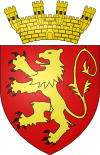Carnival tragedy of 1823
 Ta' Ġieżu church, near which the stampede took place | |
| Date | 11 February 1823 |
|---|---|
| Location | Valletta, Malta |
| Coordinates | 35°53′46.7″N 14°30′47.8″E / 35.896306°N 14.513278°ECoordinates: 35°53′46.7″N 14°30′47.8″E / 35.896306°N 14.513278°E |
| Type | Human crush |
| Deaths | c. 110 |
| Charges | None |
The Carnival tragedy of 1823 was a human crush which occurred on 11 February 1823 at the Convent of the Minori Osservanti in Valletta, Malta. About 110 boys who had gone to the convent to receive bread on the last day of carnival celebrations were killed after falling down a flight of steps while trying to get out of the convent.
Background
At the time of the tragedy, Malta was experiencing a famine[1] and it had become a tradition to gather 8- to 15-year-old boys from the lower classes of Valletta and the Three Cities to participate in a procession during the last few days of carnival. After the procession, they would attend mass, and they would be given some bread afterwards. This activity was arranged by ecclesiastical directors who taught catechism, and its main aim was to keep children out of the riots and confusion of carnival.[2]
This activity was organized on 10 February 1823, when children attended mass at Floriana and then went to the Convent of the Minori Osservanti (now better known as ta' Ġieżu) in Valletta where they were given bread. Everything went as planned, and the same procedure was planned for the following day.[2]
Disaster
The same procedure took place on 11 February 1823. Children were gathered and attended mass at Floriana, but the ceremony lasted an hour longer than usual. The children's procession to the convent in Valletta occurred at the same time as the carnival celebrations had ended, so they met with many people who were returning home. At this point, some adults and children from the crowd mixed in with the boys in order to receive some free bread.[2]
The boys entered one of the convent's corridors from the vestry door in the church, and were to be let out through another door in St. Ursula Street. The bread was to be distributed at the latter door. Although the vestry door was usually locked to prevent boys from reentering to receive more bread, this time the door was left open since the boys were late. Due to this, more men and boys entered without anyone realizing.[2]
Those who had entered began to push the boys queuing in the corridor, who were shoved to the end of the corridor near a half-open door. At this point, a lamp went out leaving the corridor in darkness, and the people inside began to push forward even more. The boys at the front fell down a flight of steps, blocking the door in the process.[2]
Those who were distributing the bread as well as some neighbours rushed to assist the children after they heard screams. They managed to open the doors, and many boys got out and were revived. However, a number of boys had already died due to suffocation or being trampled upon.[2]
The exact number of casualties is not known. Records of the Sacra Infermeria show that 94 bodies of boys aged between 15 and 16 were brought to the hospital on 11 February, and they were buried the following day. However, contemporary records such as The Gentleman's Magazine and Historical Chronicle reveal that "no less than 110 boys perished on this occasion".[1]
Aftermath
An investigation led by the Lieutenant Governor took place after the disaster, and a report about the findings was published a few days after the incident. The investigation concluded that the stampede took place as a result of a succession of errors, and no one was accused for the deaths of the children.[2]
References
- 1 2 "Flashback: Valletta stampede in 1823 killed 100 children". Times of Malta. 18 November 2016. Archived from the original on 7 April 2016.
- 1 2 3 4 5 6 7 Vella, Fiona (3 February 2016). "To die for a piece of bread". Times of Malta. Archived from the original on 19 July 2016.
Further reading
- Niles, Hezekiah, ed. (March–September 1823). "Melancholy Affair. Suffocation of one hundred and ten boys. Extract of a private letter from Malta, of February 21, 1823.". Niles' Weekly Registrar. Baltimore: William Ogden Niles. pp. 189–190.
- Further details. pp. 371-372.
